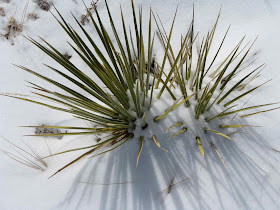What are these plants doing, besides advertising for Walmart?
They are photosynthesizing. While other grassland plants have shut down for the winter, Yucca glauca continues to crank out sugars when the sun is shining and temperatures are not too low. The tough fibrous leaves are resistant to freezing and desiccation, and their steep angles are conducive to catching rays when the sun is low in the sky.
Yucca glauca does especially well in sandy soils, probably due to less competition from other plants. It is scarce to absent in areas covered in grass. The plants are deep-rooted and rhizomatous, often forming colonies of rosettes that are connected underground.
 |
Yucca colony on sandy soil on slope of small ridge in grassland;
southeast Wyoming, USA.
|
In Wyoming, yuccas bloom in June and July, producing large cream-to-greenish flowers that are tasty to people as well as to deer and other wildlife. But on this winter day, yucca flowers are only a dream.
Photo by Lillian G. Flaigg; Lady Bird Johnson Wildflower Center.
 |
| Great Plains yucca provides a bit of greenery in an otherwise-drab midwinter grassland. |




No comments:
Post a Comment